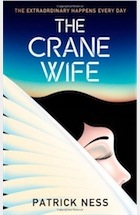Well, I think I should apologise first. I have no excuse but I didn't forget about you all.
How's life? Miss me? Nah, didn't think so. :-)
So, here's a review Imfound for you lovely people.
It's from the website http://www.guardian.co.uk/books/2013/apr/20/crane-wife-patrick-ness-review which is an awesome
website which you should look at more often.
Here goes...
In Patrick Ness's return to adult fiction after his prizewinning Chaos Walking trilogy, George – fortyish, divorced, American – hears a strange cry in the winter night, a keening (the word is italicised as if it were in a foreign language). He goes out to find a great white bird in his London back garden with an arrow in its wing. He removes the arrow and tells the crane his name; it bows and flies away, leaving George to do the keening.
The legendary situation is clear and vivid, though its development in the novel is complicated by wandering focus and constant changes of narrative tone. In George's printing shop next day we meet his Turkish assistant Mehmet, an entertaining character. The chapter, like many in the book, consists almost entirely of inconsequential dialogue, and it ends suddenly with the entry of a customer, lent drama by the paragraphing and phrasing:
'"My name," she said, "is Kumiko."'
I thought the name Kumiko might signify the crane of the Japanese legend, but my computer tells me it means something more like "child of lasting beauty". Kumiko is a sweet and mysterious lady. George, a defencelessly amiable man, naturally falls in love with her, and she with him. She shows him an artwork she has made, an image cut from white feathers on a black tile. George's own hobby involves slicing old books up into slivers and shapes of paper and collaging them; under Kumiko's inspiration he slices up a book and by joining his creation to hers makes a tile of such wondrous and meaningful beauty that all who see it are amazed, burst into tears, and want to pay vast sums of money for it. Kumiko and George go on combining their artwork, and in no time they are both rich.
Some of the tiles portray a story, appearing in sections in a different typeface, which is Kumiko's supernatural life history, or one version of it. Concurrently we get to know George's grown-up daughter Amanda, who has a difficult job with a difficult boss, distrusts herself, still loves her French ex-husband, and doesn't get much joy out of life except from her little son. Though her story is interwoven with George's, the aesthetic and psychological connection of her life with the supernatural beings her father has got himself involved with seems coincidental, perhaps accidental. You can be sure, however, if somebody with green eyes turns up, he or she is an embodiment of the great enemy, or harmful lover, or shadow-self of the crane – the Volcano. As Kumiko is the Forgiver, the Volcano is the Destroyer.
The tremendous effect of the sliced-up-book-and-feather artworks on everyone's emotions isn't made very believable, and the passages where deep mythic chords are struck ring less true than the scenes having to do with ordinary London life. The merely human characters are vivid and likeable, the story is lively and often quite funny. Momentum slackens only in the long passages of unbroken, unascribed, brief-line dialogue. Where a play or film script might use [Pause] or [Beat] as a signal to the actors, these dialogues repeatedly use ellipses-in-quotes: "…" Is the reader expected somehow to perform these silences? A script isn't a narrative; it's a quite different way of telling a story, and for me these dialogues, even when clever, fail to work as part of a novel. But expectations change with generations, and the reduction of human relationships to a back-and-forth table-tennis bounce of bodiless voices may be perfectly satisfactory to readers who spend a lot of time on a mobile phone.
This essentially light, good-natured book tries to invoke powerful, elemental emotions using a vocabulary and imagery too trite to do the job. Ness mixes highly staged drama with deliberate deflation, as when George first sees the great white crane:
"No sound came from anywhere. The two of them could have been standing in a dream – though the cold that shifted through his shoes and bit at his fingers suggested otherwise, and the quotidian leaking of a stray drop, despite his best efforts, onto the crotch of his underwear-less trousers, told him definitively this was still real life, with all its disappointments."
There is a good deal of such self-conscious striving for cool. Yet in other passages emotionality is pushed almost to the point of hysteria, while banal language reduces the beautiful central legend to sentimentality. It's too bad, because there is real kindliness in the story; and kindliness is a quality even rarer in novels than in "real life, with all its disappointments".

Hi Book Worm! Nice to meet you.
ReplyDeleteThanks for sharing this review.
I blog at:
http://rites-i-rite.blogspot.in/
Do stop by...Happy reading and blogging.